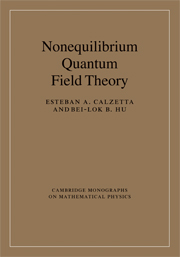Book contents
- Frontmatter
- Contents
- Preface
- I FUNDAMENTALS OF NONEQUILIBRIUM STATISTICAL MECHANICS
- 1 Basic issues in nonequilibrium statistical mechanics
- 2 Relaxation, dissipation, noise and fluctuations
- 3 Quantum open systems
- II BASICS OF NONEQUILIBRIUM QUANTUM FIELD THEORY
- III GAUGE INVARIANCE, DISSIPATION, ENTROPY, NOISE AND DECOHERENCE
- IV THERMAL, KINETIC AND HYDRODYNAMIC REGIMES
- V APPLICATIONS TO SELECTED CURRENT RESEARCH
- References
- Index
1 - Basic issues in nonequilibrium statistical mechanics
from I - FUNDAMENTALS OF NONEQUILIBRIUM STATISTICAL MECHANICS
- Frontmatter
- Contents
- Preface
- I FUNDAMENTALS OF NONEQUILIBRIUM STATISTICAL MECHANICS
- 1 Basic issues in nonequilibrium statistical mechanics
- 2 Relaxation, dissipation, noise and fluctuations
- 3 Quantum open systems
- II BASICS OF NONEQUILIBRIUM QUANTUM FIELD THEORY
- III GAUGE INVARIANCE, DISSIPATION, ENTROPY, NOISE AND DECOHERENCE
- IV THERMAL, KINETIC AND HYDRODYNAMIC REGIMES
- V APPLICATIONS TO SELECTED CURRENT RESEARCH
- References
- Index
Summary
Perhaps due to its technical complexity, oftentimes one sees in research papers on nonequilibrium quantum field theory (NEqQFT) more emphasis placed on the field-theoretical formalisms than the ideas these sophisticated techniques attempt to capture, or the issues such problems embody. All the more so, we need some basic understanding of the important issues and concepts in nonequilibrium statistical mechanics (NEqSM), and how they are manifested in the context of quantum field theory. Many important advances in this field came from asking such questions and finding out how to answer them in the language of quantum field theory. Because of this somewhat skewed existing emphasis in NEqQFT, and since we do not assume the reader to have had a formal course on NEqSM before, we shall give a brief summary of the basic concepts of NEqSM relevant to the field-theoretical processes discussed in this book. Many fine monographs and reviews written on this subject take a more formal mathematical approach. approach. Since our purpose here is to familiarize readers with these issues and their subtleties, rather than training them to work in the rich field of NEqSM (which includes in addition to the traditional subject matter such as the projection operator formalism and open system concepts, also current topics at their foundation, such as dynamical systems and quantum chaos), we choose to approach these topics in a more intuitive and physical way, sacrificing by necessity rigor and completeness.
- Type
- Chapter
- Information
- Nonequilibrium Quantum Field Theory , pp. 3 - 38Publisher: Cambridge University PressPrint publication year: 2008



